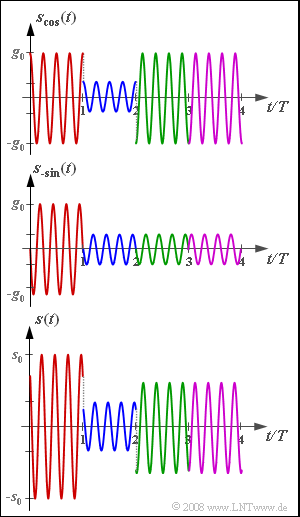Exercise 4.10: Signal Waveforms of the 16-QAM
Let us consider the 16–QAM method according to the block diagram in the theory section.
Very briefly, it can be described as follows:
- After serial-parallel conversion and subsequent signal space assignment, four bits of the binary redundancy-free source signal q(t) at the input each result in a complex-valued amplitude coefficient
- a=aI+j·aQ.
- With the rectangular transmission pulse gs(t) in the range from 0 to T and of height g0, after multiplication with the cosine function or minus-sine function in the given time interval, we obtain:
- scos(t)=aI⋅g0⋅cos(2πfTt),
- s−sin(t)=−aQ⋅g0⋅sin(2πfTt).
- The 16-QAM transmitted signal is then the sum of these two component signals:
- s(t)=scos(t)+s−sin(t).
The graph shows the signals scos(t), s_{\rm –sin}(t) and s(t) for four selected symbols. Using these, the amplitude coefficients are to be determined.
Hints:
- This exercise belongs to the chapter "Quadrature Amplitude Modulation".
- The page "Signal waveforms for 4–QAM" is helpful for completing this exercise.
- The signal space allocation considered can be seen in Exercise 4.10Z. The color highlights also correspond.
- From question (6) onwards, use the parameter values g_0 = 1 \ \rm V and T = 1 \ \rm µ s.
- Energy values are to be given in \rm V^2s ; like this, they refer to the reference resistance R = 1 \ \rm \Omega.
Questions
Solution
- s_{\rm cos}(t)= a_{\rm I}\cdot g_0 \cdot \cos(2 \pi f_{\rm T} t)= g_0 \cdot \cos(2 \pi f_{\rm T} t)\hspace{0.3cm}\Rightarrow \hspace{0.3cm}a_{\rm I}\hspace{0.15cm}\underline {= +1} \hspace{0.05cm}.
- Accordingly, we recognize from the quadrature signal ⇒ imaginary part:
- s_{\rm -sin}(t)= -a_{\rm Q}\cdot g_0 \cdot \sin(2 \pi f_{\rm T} t)= -g_0 \cdot \sin(2 \pi f_{\rm T} t)\hspace{0.3cm}\Rightarrow \hspace{0.3cm}a_{\rm Q}\hspace{0.15cm}\underline {= +1} \hspace{0.05cm}.
(2) The two partial signals each have the (maximum) envelope g_0, while s_0 characterizes the transmitted signal s(t).
- As can be seen from the signal space allocation (see Exercise 4.10Z) :
- {s_0}/{ g_0 }= \sqrt{2}\hspace{0.15cm}\underline { = 1.414} \hspace{0.05cm}.
(3) The amplitude coefficients a_{\rm I} and a_{\rm Q} have the same signs as in subtask (1), but with smaller magnitude:
- a_{\rm I} = + 1/3\hspace{0.15cm}\underline {= +0.333} \hspace{0.05cm},\hspace{0.5cm}a_{\rm Q} = + 1/3\hspace{0.15cm}\underline {= +0.333} \hspace{0.05cm}.
(4) In the third (green) interval, we can see a minus-cosine signal with amplitude g_0 and a minus-sine signal with amplitude g_0/3:
- a_{\rm I} = \hspace{0.15cm}\underline {= -1} \hspace{0.05cm},\hspace{0.5cm}a_{\rm Q} = + 1/3\hspace{0.15cm}\underline {= +0.333} \hspace{0.05cm}.
- As is yet to be calculated in sub-task (4) of Exercise 4.10Z, here the magnitude is equal to |a| =1.054 and the phase angle is {\rm arc} \ a \approx 161^\circ.
(5) The violet signal does not differ from the green interval in the in-phase component except in the sign of the quadrature component:
- a_{\rm I} = \hspace{0.15cm}\underline {= -1} \hspace{0.05cm},\hspace{0.5cm}a_{\rm Q} = - 1/3\hspace{0.15cm}\underline {= -0.333} \hspace{0.05cm}.
(6) The maximum signal energy occurs when one of the four outer vertices is occupied. In that case:
- E_{\rm S, \hspace{0.05cm}max} = {1}/{2}\cdot s_0^2 \cdot T = {1}/{2}\cdot \left (\sqrt{2} \cdot g_0 \right )^2 \cdot T = g_0^2 \cdot T = (1\,{\rm V})^2 \cdot (1\,{\rm \mu s}) \hspace{0.15cm}\underline {= 10^{-6}\,{\rm V^2s}}\hspace{0.05cm}.
- The average signal energy is equal to the maximum value when only the corner points of the signal space mapping are occupied and the "inner symbols" are excluded from the encoding.
(7) Four bits are transmitted per symbol. From this it follows that:
- E_{\rm B, \hspace{0.05cm}max} = {E_{\rm S, \hspace{0.05cm}max}}/{4}\hspace{0.15cm}\underline {= 0.25 \cdot 10^{-6}\,{\rm V^2s}}\hspace{0.05cm}.
(8) The minimum signal energy is obtained at one of the inner signal space points and is smaller by a factor of 9 than in subtask (7):
- E_{\rm B, \hspace{0.05cm}min} = \frac{E_{\rm B, \hspace{0.05cm}max}}{9} = \frac{g_0^2 \cdot T}{36} \hspace{0.15cm}\underline { \approx 0.028 \cdot 10^{-6}\,{\rm V^2s}}\hspace{0.05cm}.
- In the theory section, it was shown that, assuming all symbols are equally likely, the average signal energy per bit for 16-QAM is approximately:
- E_{\rm B} \approx 0.139 · g_0^2 \cdot T = 0.035 \cdot 10^{-6}\,{\rm V^2s}.
